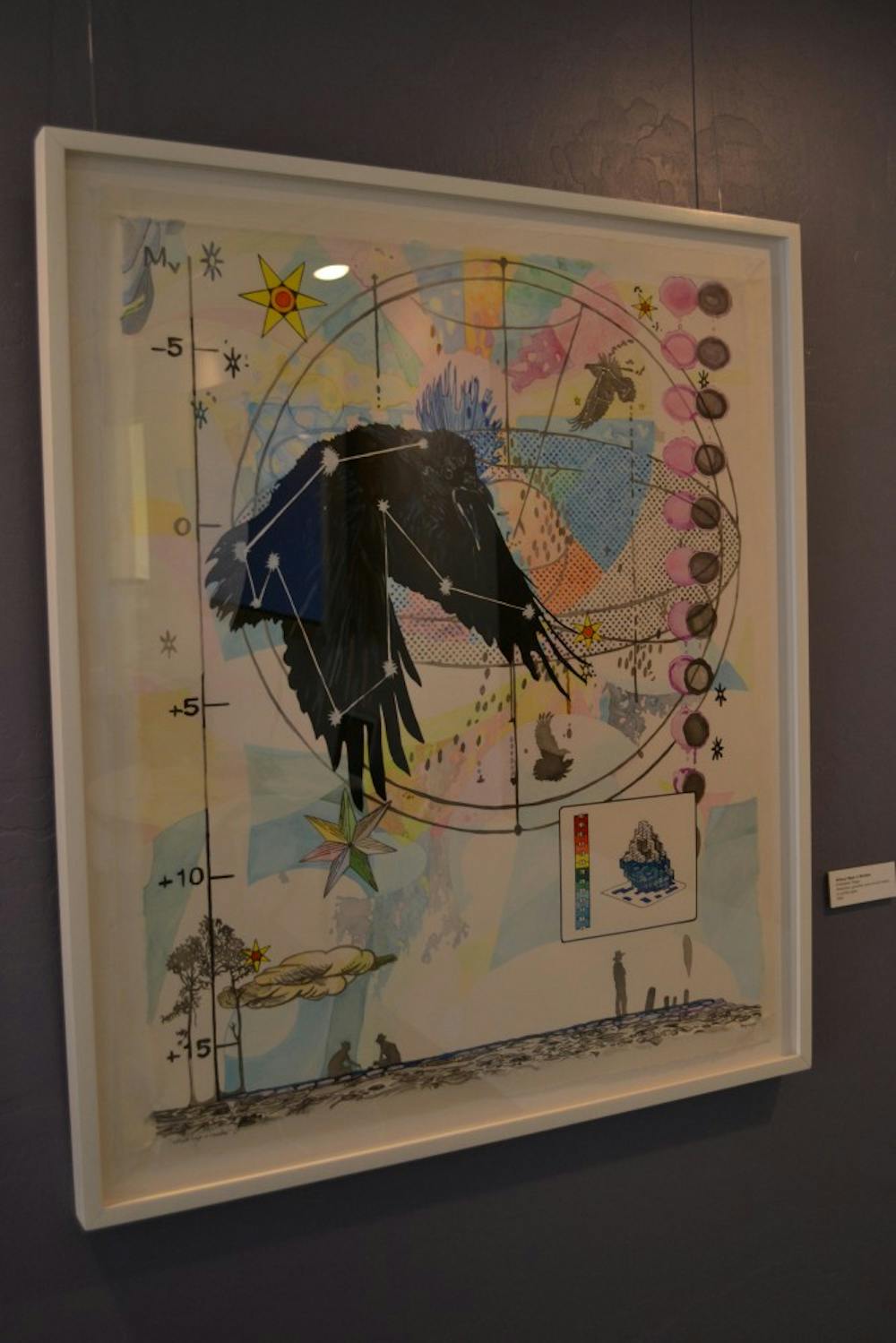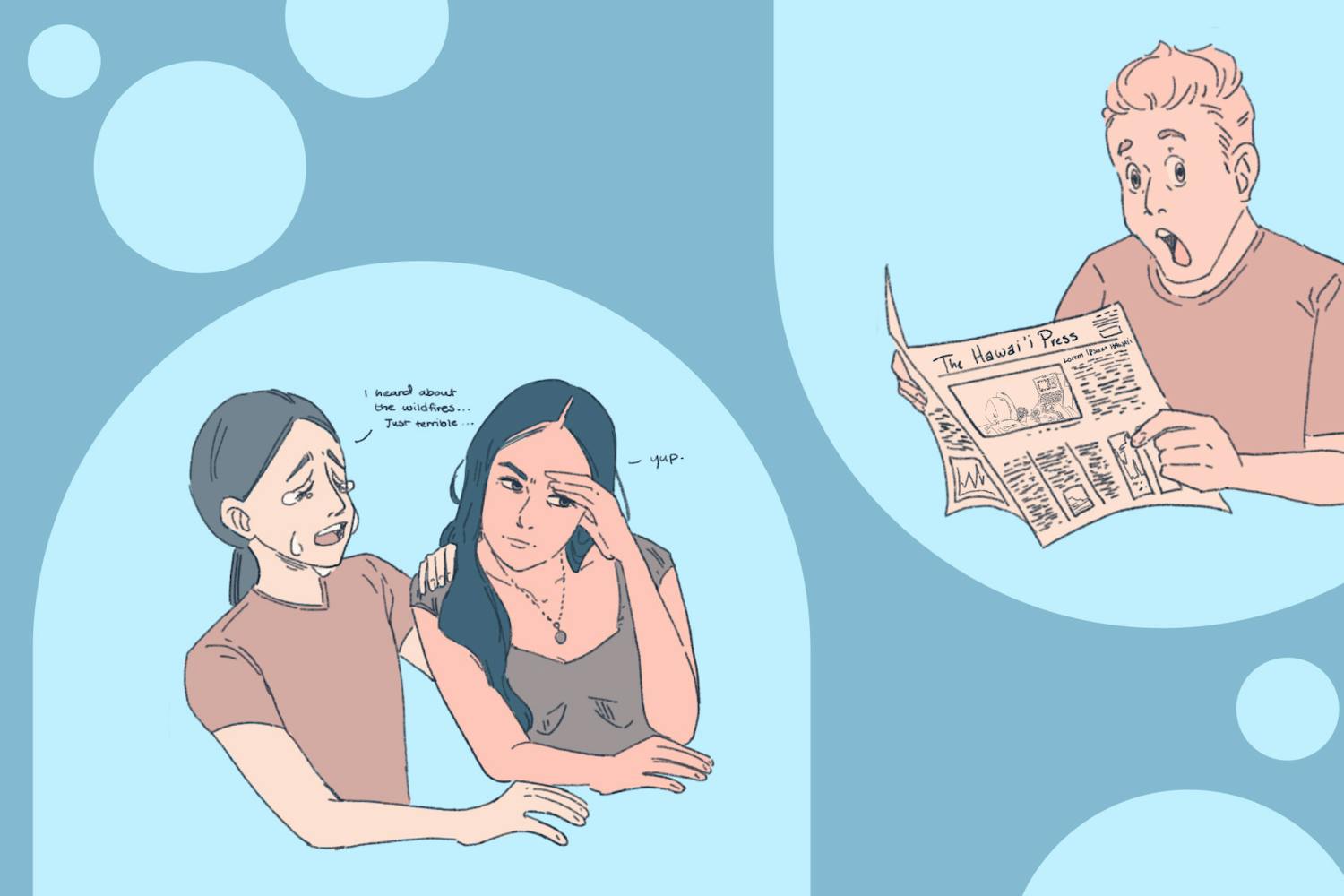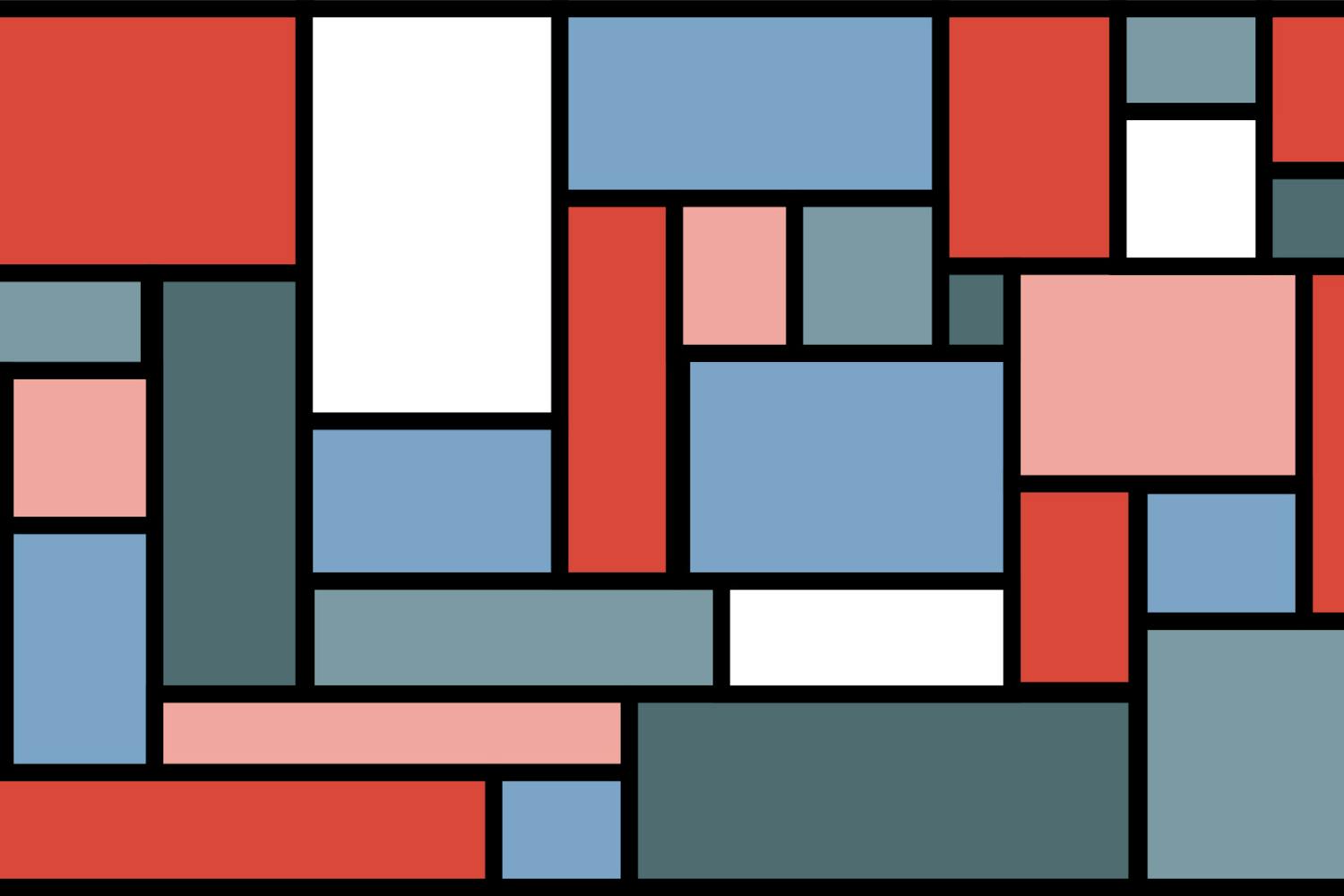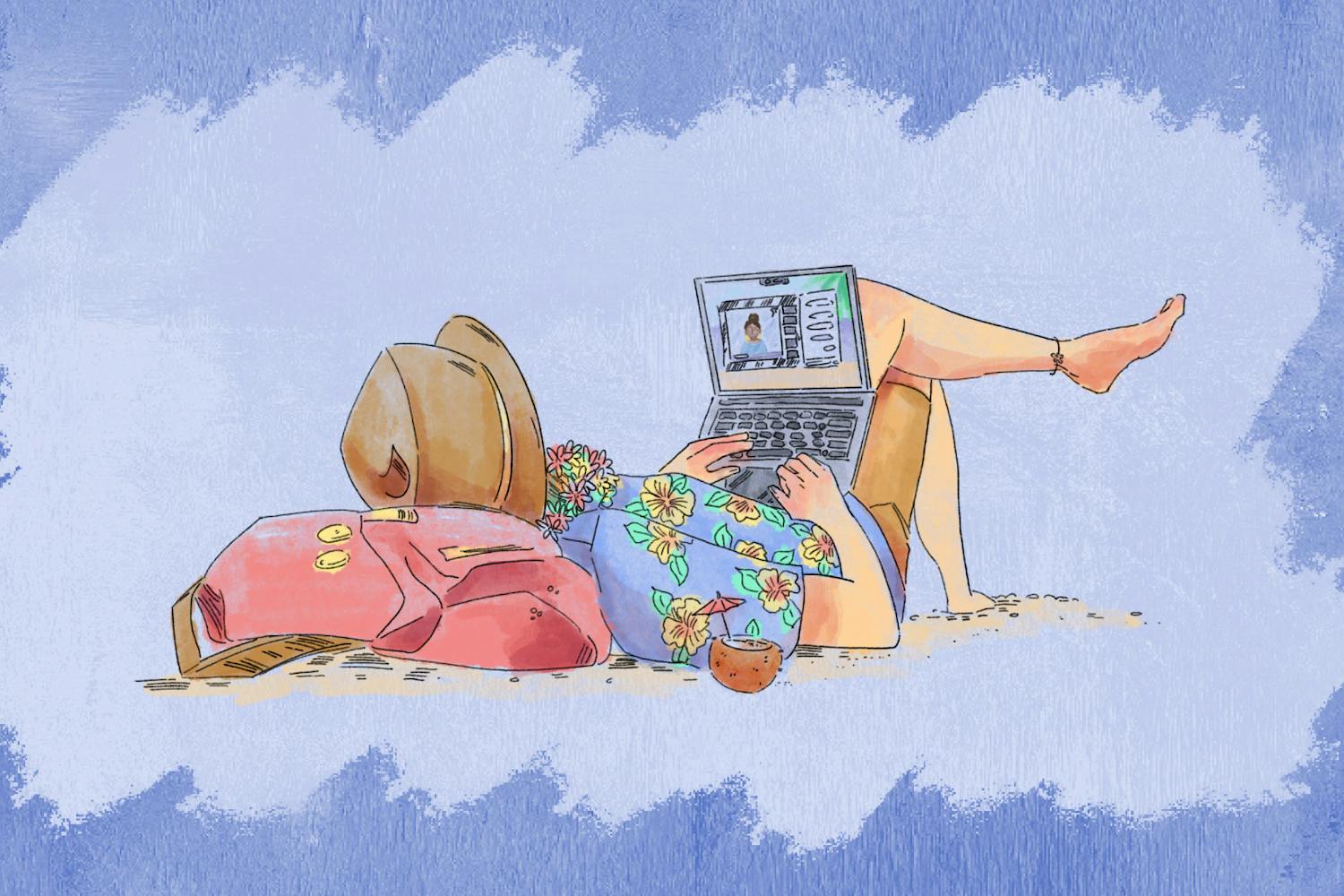 Kevin McHugh and Jennifer Kitson stand by their infrared images that resolve on the screen in vibrant colors.
Kevin McHugh and Jennifer Kitson stand by their infrared images that resolve on the screen in vibrant colors.Photo by Mackenzie McCreary
The art hangs in a semi-cramped room with one bold purple wall opposite the entrance of the conference room. Each piece invites viewers to engage their subconscious creativity.
There’s a small photo of a girl in two places at once, a sculpture of a baby’s bust atop a stack of books, a line of tiny, delicate dresses, and a video of distorted images in vibrant colors that seem to be mere decoration.
But upon closer inspection, they reveal an enormous realm of imaginary possibility both gleeful and grim.
“Imagination is not your conscious thought, so of course it could be full of dark things,” says Nathaniel Clark, a painter whose work is in the exhibit. “It’s obviously a good thing to have it come out in painting as opposed to things like school shootings.”
Each year the Institute for Humanities Research hosts its Fellows Program. This program offers scholars from across the country the chance to conduct research, collaborate with ASU faculty and write about their respective findings.
 Jeff Falk’s mixed media piece, “Augury (Tar Baby’s Vision)” commands a corner with its haunting presence.
Jeff Falk’s mixed media piece, “Augury (Tar Baby’s Vision)” commands a corner with its haunting presence.Photo by Mackenzie McCreary
The theme of this year’s Fellows Program addresses the concept of imagination and seeks to bring the arts and the sciences together for a unique look at the human experience.
However, in our ever-advancing world of technology and science, the imaginary is often thought of in terms of invisible friends and playground games.
IHR sees two sides of the idea.
On one side, according to a press release, imagination can, “empower sound ethical decision making, resuscitate our humanity when we falter, enliven forgiveness, love and hope in the human heart….”
But they also see it’s a double-edged sword when it comes to the creativity of the human mind.
“Yet, imagination may also condemn humanity to irrational delusions, apocalyptic visions… and unethical imaginary motifs and practices,” the post states.
Just looking at all of the recent dystopian phenomena that have taken hold of our modern literary and film cultures, such as “I am Legend” and “The Hunger Games,” it’s no wonder there are dark ideas lurking about in the imagination.
“The role of the imagination is important for calling our present-day reality into question, but also as a way that connects the past, present and future,” Daniel Gilfillan, the acting director with IHR, says. “We use the imagination to really think cognitively about where we’d like to see ourselves going as a culture and what the steps would be to get us there.”
Gilfillan explains the role of imagination in the humanities as a process of looking at an issue that needs to be addressed in the present and working toward a future without that complication.
However, Gilfillan says that while working toward goals of a better world, society may inadvertently create other obstacles that are just as serious. This is the downside.
We can think about a future without environmental hazard, but what if that creates some other kind of problem in business or among the public?
While some aspects of research being done for this year’s Fellows Program are visual, many are more abstract and hold a firm place in the mental work rather than the physical interpretation.
Christina You-Sun Park, a sculpture student currently pursuing her master of fine arts degree at ASU, faced a difficult task when she was putting together IHR’s annual Fellows Art Exhibit.
To find art that visually expressed that which is abstract was a challenge.
 “Venus Black Jewels, #12” is one of a series of mixed media pieces done on brown paper bag by Francoise Duresse.
“Venus Black Jewels, #12” is one of a series of mixed media pieces done on brown paper bag by Francoise Duresse.Photo by Mackenzie McCreary
When Park decided to apply for the job of curating IHR’s exhibition, she knew she had to get as wide a variety of art as possible.
Park put out calls for art across the nation in New York and California, as well as throughout Arizona. “It got a really great call back and we had more than 150 artists who could submit about three pieces each,” she says.
While she was going through the review process, she says she did three different scans of the work that had been submitted. One of the main things she looked for was whether the piece had any discernable connection with the imagination.
“There were very few that were like that because the arts is so based on the imagination,” she says with a laugh.
She also thought about how the art pertained to IHR and the ideas they are studying, as well as how all of the pieces work together and play off of each other.
“Their definition is like the widest variety of imagination you can think of, but it’s very academic,” Park says. “Because they are such an academic research department and the arts is more free-form and thinks a little differently, it was interesting to merge them together.”
Park says she wanted to see the imagination in the present day with the art in this show.
“I was looking for work that critically looked at how we use imagination in this world of technology and science that’s motivating us forward,” she says.
Park also says that the sense of duality and the sense of self were major themes that both answered the ideas of IHR, but also spoke to imagination in terms of the art world.
The different pieces of art range from traditional painting to printing, fibers, video and sculpture.
One piece that stayed within traditional art forms is an oil-on-canvas piece by Clark called, “I Stumble Upon the Canyon of Strange, Contrived, Birds.”
 Nathaniel Clark’s “I Stumble Upon the Canyon of Strange, Contrived, Birds,” dominates the deep purple wall of room 109 in the Social Sciences building.
Nathaniel Clark’s “I Stumble Upon the Canyon of Strange, Contrived, Birds,” dominates the deep purple wall of room 109 in the Social Sciences building.Photo by Mackenzie McCreary
The piece shows a young child peering into a dim canyon filled with foreign birds and creatures as the sun shines down on the fields behind him.
“This piece kind of brings out the sense of the imaginative realm with the kind of otherworldly beings,” Gilfillan says. “His reality is behind him and this opening provides a screen to what could be in front of us.”
Clark says that he heard about the show through one of the national calls. When painting his piece, he knew what he wanted the piece to be in some ways in terms of composition, such as the idea of the dark canyon on both sides and the light in the middle, as well as the sense of looking in on something from the outside, he says.
However, he says he has no idea where the idea for the birds came from.
“The whole thing is an invention,” Clark says. “It’s not really a conscious decision to engage the imagination it’s really giving yourself permission to let your self-conscious come out.”
Another piece done by Christopher Reiger, called “without maps or manifest,” brings in more of a scientific and historic look at imagination through time to what it is today.
What seems to be a measuring scale runs up the side of the image. A globe backgrounds a raven with connecting dots that seem to reference constellations in the sky.
Yet at the bottom, figures appear almost as ghosts as their cowboy hats embody the American West and its myths.
“The painting is essentially a picture of the humanities’s ‘two steps forward, one step back’ type of progress, but also our capacity for making sense in terms of that progress,” Reiger says.
Reiger’s inter-media piece is a collection of both adventure and the knowledge and things we take with us when embarking on a quest. It also combines elements of America’s past and manifest destiny.
Yet, another piece moves fully into the scientific realm of the imagination.
Kevin McHugh, associate professor in the School of Geographical Sciences and Urban Planning, and Jennifer Kitson, a geography graduate student, submitted a video piece called “The Thermal City.”
As part of an academic research project on infrared imaging, McHugh and Kitson used a special type of camera that can detect the heat within all different kinds of objects.
“This idea of the thermal imagination is what we’ve been investigating,” Kitson says. “The ways the intensities around hot and cold are constantly bombarding humans and moving us in different ways are what we are looking at with this camera.”
They also study the ways science and philosophy overlap by referencing ideas from H.G. Wells’ fictional invention of a heat-ray from “War of the Worlds.”
“The infrared camera makes visible, that which is invisible, heat,” McHugh says. “To us it’s an explosive imaginary because there is this visible thing moving between us and in us always, but it’s usually invisible.”
 Christopher Reiger’s mixed media piece, “without maps or manifest,” combines aspects of American history with timeless tools used for advancement throughout the years.
Christopher Reiger’s mixed media piece, “without maps or manifest,” combines aspects of American history with timeless tools used for advancement throughout the years.Photo by Mackenzie McCreary
For their piece, McHugh and Kitson took infrared photos of different objects and even people. The infrared can distort what we might normally categorize the subject to be.
“These images can enchant, but they can also bedevil,” McHugh says. “As each image arises, you never know what it’s going to be [and] that’s a world of possibility.”
McHugh says that in the infrared world, things are so unexpected that there is a heightened sense of mystery and curiosity that let the viewers’ imagination go as they try to classify the image in their minds.
“The relief that comes with knowing what something is and the consternation that arises when you don’t know what it is… I think all work at the imagination,” McHugh says.
As the rest of the art spans from completely artistic to mostly scientific, a discussion arises between both artist and researcher about imagination.
Because the concept of the imaginary is so wide with many facets that can all be interpreted in several ways, nailing down a specific definition is practically impossible.
After reading IHR’s brief definition of imagination, Clark wrote in an email correspondence: “Nor do I feel that imagination ‘allows us to transform reality or liberate the ways we think.’ Reality remains reality. It is our perception and understanding of reality that might change.”
He also wrote, “It [imagination] is the world of images and intuitions, of symbols and unconsciousness; and this world, for all its intangibility, trumps the concrete one we live in.”
While the feelings vary between the artist and the scholar, both sides activate a conversation about the imagination that serves pertinent to a world quickly advancing into the future.
IHR’s exhibit is on display room 109 in the Social Sciences building, and floors three and four of Wrigley Hall in the Global Institute of Sustainability building. Room 109 is open Mon.-Fri., 8 a.m. to 5 p.m. and can be viewed whenever the room is not being used.
Those wishing to view the art in this room should check with the assistants in room 107 of the Social Sciences building for the times for when the room will be free for viewing.
The show will remain on display until April 26 to encourage thinking and discussion on the complex subject that is the imagination and the imaginary.
Reach the writer at mamccrea@asu.edu or via Twitter @MackenzieMicro




